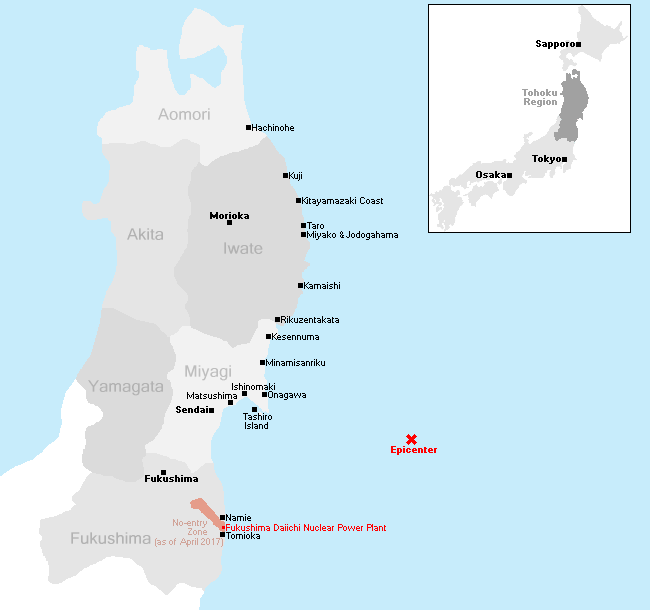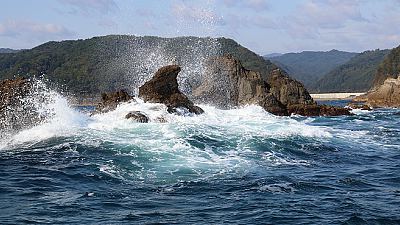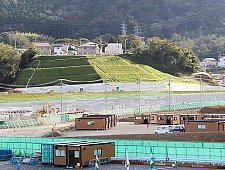Six years after the tsunami

This is the twelfth part of our open-ended series to document the recovery of the tsunami-hit coast of northeastern Japan where nearly 20,000 people lost their lives, and entire towns were destroyed in the afternoon of March 11, 2011. Six years after the tsunami, we revisited some of the worst hit cities along the Sanriku Coast in Miyagi and Iwate Prefectures and also drove down the coast of Fukushima Prefecture on April 24-26, 2017.

The enormous task of elevating the ground of coastal districts by several meters and re-enforcing the waterfront is finally approaching completion in many municipalities along the Sanriku Coast, clearing the stage for the actual rebuilding of the former town centers. Meanwhile, transportation along the coast is steadily becoming faster as new sections of the Sanriku Expressway are opened.
This time, we started our visit in Miyako City in Iwate Prefecture and followed the Pacific Coast southwards all the way to Tomioka City, south of the Fukushima Daiichi Nuclear Power Plant, before returning to Rikuzentakata to visit a newly opened shopping mall.





In Miyako, we revisited Jodogahama Beach where efforts to restore the infrastructure for tourists have mostly been completed. We stayed at the Jodogahama Park Hotel, which is attractively surrounded by pine trees and allowed for an early morning walk to the beach to witness the sunrise.

Compare: April 2017 - April 2011




Compare: April 2017 - April 2011
In Rikuzentakata, we visited the new Abasse Takata shopping center on its opening day. It is the first complex being opened in the former city center which was completely destroyed in March 2011 and has since been elevated by over ten meters in order to protect it from future tsunami. It was particularly satisfying to see the reopening of the Maiya supermarket whose ruins have for months shaped the skyline of Rikuzentakata's destroyed former city center. The city has also seen the completion of its new seawall along which a tsunami memorial park is being planned.



Compare: April 2017 - April 2011




In Kesennuma, the badly damaged Shishiori district is gradually coming back to life. Elevated by a few meters, the district is seeing the completion of a growing number of new buildings, including massive apartment blocks that also serve as tsunami evacuation buildings.

Compare: April 2017 - May 2016


In Minamisanriku, too, a new shopping center has opened on elevated land in the former town center. Initially opened further inland a year after the tsunami, the Sunsun Market moved to its new location this spring. Efforts are ongoing on fortifying the town's coastline and coastal districts. Access to Minamisanriku has become faster thanks to the extension of the Sanriku Expressway last October.




Compare: April 2017 - May 2016




Further south, we also visited Onagawa and Ishinomaki to witness gradual process in the rebuilding of their coastal districts.


Compare: April 2017 - April 2015

Compare: April 2017 - April 2015

Compare: April 2017 - April 2011

Compare: April 2017 - April 2011
One year after our first journey down the coast of Fukushima Prefecture, we revisited Namie Town north of the Fukushima Daiichi Nuclear Plant and Tomioka Town south of it. The evacuation order was lifted for wide areas of both towns on April 1 this year. So far, however, only very few shops have reopened, and reconstruction of damaged infrastructure is still ongoing (or has only just started). Not surprisingly, only a very small percentage of the former population has returned so far, and more time is needed to revive the two towns that have stood empty for over half a decade.








Trains returned to Namie earlier this month and are scheduled to start servicing Tomioka again from this October. Efforts are made to restart service along the entire Joban Line by spring 2020.




















